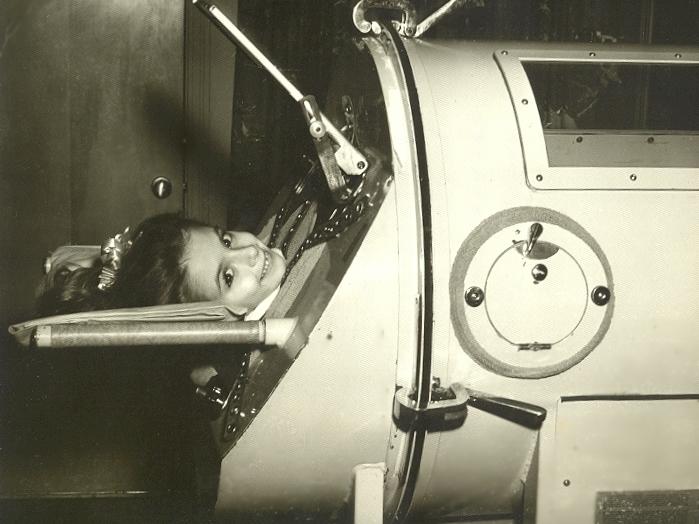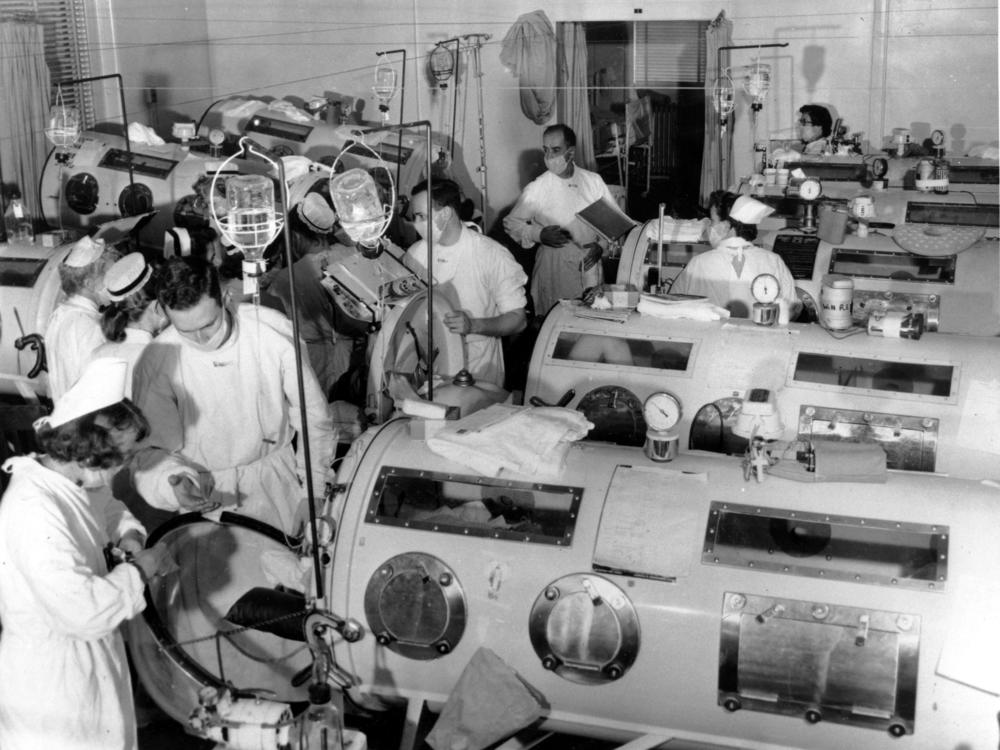Section Branding
Header Content
Decades after polio, Martha is among the last to still rely on an iron lung to breathe
Primary Content
On June 8, 1953, Martha Lillard celebrated her fifth birthday with a party at an amusement park in Oklahoma. A little over a week later, she woke up with a sore throat and a pain in her neck. Her family took her to the hospital, where she was diagnosed with polio.
She spent six months in the hospital, where she was put in a giant metal tank — a ventilator informally called an iron lung — to help her breathe. To this day, Lillard is one of the last people in the U.S. who still depends on an iron lung to survive.
Polio is a potentially life-threatening disease, once among the world's most feared. In the late 1940s, polio disabled an average of 35,000 people in the U.S. every year.
A polio vaccine became widely available in 1955, and millions of Americans got vaccinated. Since 1979, no cases of polio have originated in the U.S., according to the Centers for Disease Control and Prevention. The disease has been nearly eradicated — the World Health Organization documented only 175 cases of wild polio in 2019. It remains endemic in only Pakistan and Afghanistan.
Although most people who contract polio will not have visible symptoms, a severe case can infect the brain and spinal cord and cause paralysis. Lillard's breathing muscles were weakened by the disease, and she survived thanks to the iron lung.
The machines are giant ventilators about 7 feet long. Patients lie inside with just their heads resting outside; a seal around the patient's neck creates a vacuum. Bellows at the base of the device do the work of a human diaphragm — they create negative pressure so the user's lungs fill with air, and positive pressure allowing the person to exhale.
Sixty-eight years later, an iron lung is still keeping Lillard alive — she sleeps in it every night. While many people who had polio or post-polio syndrome either weaned themselves off the machines or switched to another form of ventilator, Lillard never did.
"I've tried all the forms of ventilation, and the iron lung is the most efficient and the best and the most comfortable way," she told Radio Diaries.
The antiquated machines are now more likely to be found in a museum than in someone's home. In the 1990s, when her iron lung was breaking down, she called hospitals and museums that might have had old ones in storage. But they'd either thrown them away or didn't want to part with their collection. She eventually bought one from a man in Utah — the machine she still uses today.
The machines were once serviced by Philips Resperonic, but Lillard says the assistance she received from the company was minimal. Once, she says a technician was sent to service her machine and prepared to leave before putting the machine back together.
Lillard has gotten stuck in the iron lung. She lost power when an ice storm came through Oklahoma and her emergency generator didn't kick on, leaving her trapped in the device without heat.
"It's like being buried alive almost, you know — it's so scary," Lillard says. She tried to call 911, but the cell towers weren't working. "I was having trouble breathing. And I remember saying out loud to myself, 'I'm not going to die.' "
Lillard was eventually able to get a signal, but she remembers the emergency responders had no idea what an iron lung was. Luckily, they were able to get the generator going for her.
Wear on parts is her main issue now. The belts need to be replaced every few weeks, the cot inside every six months, the motor every 12 years or so.
Her most immediate need is collars. The collars create the critical airtight seal around the neck. Each one lasts only for a few months. And she has bought all the back stock of collars from places that don't produce them anymore.
"That's the main thing I'm having a hard time with, because I try to stretch out, make these collars last longer," Lillard says. "And when they start deteriorating, it gets harder and harder to breathe as they leak more."
She has only a handful of collars left. "I really am desperate," she says. "That's the most scary thing in my life right now — is not finding anybody that can make those collars."
Today, Lillard spends much of her time alone. She paints, watches old Hollywood movies and takes care of her beagles. She has been mostly isolating throughout the COVID-19 pandemic, seeing her sister, Cindy, and her brother-in-law, Daryl, in the evenings.
Being affected by polio at such a young age has meant Lillard hasn't been able to have all the experiences others have had. She attended school from home for much of her childhood and couldn't participate in most extracurricular activities — she still remembers longing to go camping with her siblings. She was not able to have children or hold a steady job because of her physical limitations.
Although some of her life experiences were limited, Lillard thanks a childhood friend named Karen Rapp for teaching her to appreciate small things. Together, they observed ants and built little villages of grass huts.
"There's much more to see if you really look for it," she says.
And she's grateful for the iron lung.
"It's what sustains me. It's what heals me. It's what allows me to breathe the next day," Lillard says. "I look at it as a friend, as a very dear friend."
This story was produced by Erin Kelly and Alissa Escarce of Radio Diaries. It was edited by Deborah Shapiro, Benjamin Shapiro and Joe Richman. Thanks also to Nellie Gilles, Mycah Hazel and Stephanie Rodriguez. You can hear more stories like this one on the Radio Diaries podcast.
Copyright 2021 NPR. To see more, visit https://www.npr.org.



